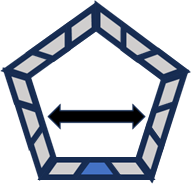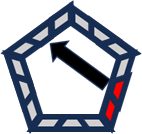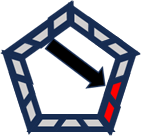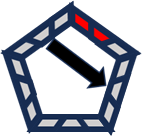| Megaminx
A5CP method |
| |
| Introduction |
| The
A5CP is an intermediate method for the PLL phase of the megaminx. A5CP means
Avoid 5 Corner PLL's (5CPLL) which describes the goal of the method. There
are more 5CPLL's than 3 and 4 corner PLL's together (8 vs 7). 4 of them only
have a probabilty of 1 (instead of 5 for the most PLL's). The other 4 are
difficult to recognize. In 40% of all solves you will get a 5 CPLL! By
learning different EPLLs we can avoid the 5CPLL's. We only need 3 extra EPLLs
per EPLL case, which is a total of 9 and only 1 more than learning all
5CPLLs. We will see that most of the 9 extra EPLLS are easy algorithms and/or
mirrors. So I think it's easier to learn these algorithms than all of the
5CPLL's. |
| |
| Which basic level do you
need? |
| You
already know how to solve the megaminx in 4 Look Last Layer. If you use
commutators for CPLL I recommand to start learning 3CPLLs and 4CPLLs first.
If you want to learn full PLL this method makes the step from 2 look PLL to 1 look PLL
easier. |
| |
| The method |
| The
basic 4LLL method uses 5 EPLLs. But in fact by moving the U face there
actually are only 3 different EPLL case |
|
|
| The
blue edges are the edges on the right place. The arrow describes how the
other edges have to move. It's important tot hold your megaminx in the same
direction by using U moves. For the third case it doesnt matter because each
direction is the same. |
| |
| The
algorithms |
| The
method use the next 12 algorithms, which are named as the PLL case they
represent with someties a U-premove to get your U face in the right
direction. For most of the cases there are alternative algorithms available
at several websites. You can use them as well, but the U-premove might be
different. |
| |
| J1+: R U R' F' R U R' U' R' F R2 U' R' |
| (U2) J1-: (U2) R' U L' U2'
R U' R' U2 L R |
| L4-: R U2' R' U2 R U2 R' U R' U' R U' R
U' R' U' R' |
| (U') L2: (U')
R U2 R' U R U' R' U' R U' R2' U' R U' R' U' R U R' U2 R |
| N2+: R L U2 L' U R' L U' R U2 L' U2 R' |
| N2-: R' L' U2' R U' L R' U L' U2' R U2' L |
| X1: F U2 R U2' R' U R U R' U2' F' R' U' R
U2' R' U2' R |
| B2+: R2 U R2' U2 R U2' R U R' U' R U' R2' U2
R U R' |
| F1-: R2 U2' R2' U'
R2 U2' R2' |
| U (T1): (U) R U R' U' R' F R2 U' R' U' R U R' F' |
| (U) X5+: (U) R' U R U2 R'
U2 R U R2' U' R U' R' U' R U2 R' U R2 |
| (U2) L1: (U2) R' U2 R U R'
U R U' R' U2 R U' R U R' U R U2' R' |
| |
| Group
1 (J1+) |

|
| First
watch for a pair, if there are more than one, just choose one you like. If
the pair is on a green spot use J1+ if its on a red spot use (U2) J1-. I Prefer to look at the first 4 (easy to
see) spots to find the pair, otherwise if its one of the next 3 spots it's
red. If not it's green. |
|
|
|
|
|
|
| When there is no pair.
Look if you see one of the two "semi"-pairs below. If you do use
L4- |
|
|
| In alle other cases use
(U') L2 |
| |
| Another
easy to recognize situation is very helpful, if there is a block anywhere,
it's always possible to use J1+ (or J1- whatever you like most). So you dont
need to check where the pairs are. Just use U-turns to put the U-face in the
right direction and use J1+. If there is no block, you have to look for
pairs. |
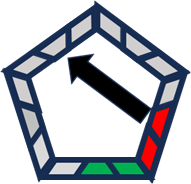
|
| |
| Group 2 (N2+) |

|
| This
case is symetric. It doesnt matter which U moves you do, it's always the same
edgecase. Look for a pair and use U moves to bring it to the front. If it's
positioned right use N2+ (7 cases) |

|
| If it's positioned left
use N2- (5 cases) |

|
| If there is no pair look
for a anti-block. If there is one use X1 (2 cases) |

|
| If there is no pair and
no anti-block use B2+ (2 cases) |
| |
| Group 3 (F1-) |
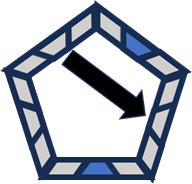
|
| This
case is a little bit more complicated. First we look for a pair again, but in
contrary to the other 2 cases we can't use each pair we find. If there is a
pair on a green spot use F1-, if the pair is on a red spot use (U) T1. If the
pair is on a other spot: ignore it, look for another pair or go to the next
step if there aren't any. |
|
|
|
|
| If
you can't find a pair on a green or a red spot. Look at the right front.
If it's an anti-block use (U) X5+. |
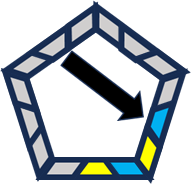
|
| In all other cases use
(U2) L1. |
| |
| EPLL already solved |
| Sometimes
after OLL the EPLL already is solved which lead you directly in a CPLL case.
Actually that's a fourth group of cases. But I think it doesnt need much
attention here. If it's a 3CPLL or 4CPLL: feel lucky, you got yourself a
skip. If it's a 5CPLL, you still solve your Megaminx in 2 steps, starting
with a 3CPLL or 4 CPLL you like the most at the right spot and leaving a 3-
or 4CPLL as well. You can figure this out by yourself. |
| |
| Improving the method |
| This
version of the A5CP method isn't
optimized. I just search for 4 PLL's per group which together cover all cases
in that group, takin into account that recognition don't have to be to
difficult. Probably there are
combinations of PLL algs that will also cover the whole group and have
easier recogintion or just are easier algorithms. |
| Another
potential improvement is to extend the 3 groups to 5 groups, the same way
that there are 5 EPLL's instead of 3. You won't loose time anymore by
searching the right direction in group 1 and 3. But you need max 2x4=8 extra
algorithms or just learn the different U-premoves and use the same algorithms
as above. |
| You
are invited to improve the method (and my bad English). Let me know if you
have something to contribute at kubus@paidiagames.nl. But most importly:
"Have Fun" |
|









